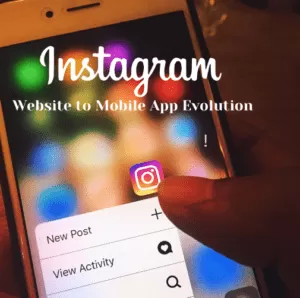Instagram: Website to Mobile App Evolution-The rapid rise
Introduction to Instagram origin’s
In the realm of digital innovation and social networking, Few platforms have advanced as far as Instagram in terms of social networking and digital innovation. It was once designed as a web-based photo-sharing platform, but when it evolved into a popular mobile application, it completely changed how we take, share, and interact with visual content.
This blog explores the intriguing history of Instagram, following its beginnings as a website and revealing an important turning point that launched it to the top of the mobile app market. Come along as we examine the development, difficulties, and amazing success story of Instagram’s rise from a simple website to a global cultural icon.

History
The most popular social media app, Instagram, was co-founded by Kevin Systrom and Mike Krieger in 2010.When Instagram first launched, it was a photo-sharing app available only on iOS. Image-enhancing filters drove its remarkable rise, gaining a million members in just two months. Its 2012 acquisition by Facebook prompted its extension to Android and, subsequently, the web. With 200 million users by 2014, it placed a strong emphasis on user interaction through likes and comments. With the introduction of Stories in 2016 for short-term sharing and IGTV to 2018 for long videos, the platform kept up its innovative streak. With the introduction of Reels, algorithm-driven timelines, and shopping capabilities, Instagram attained 1 billion active users by 2021. It has revolutionised social networking by evolving from a photo-sharing app to a flexible platform and making a lasting impact on digital storytelling and global visual culture.
The Reason of the Rapid rise
-
- Instagram’s visually appealing and user-friendly interface made sharing photos easy and fun. Its user-friendly interface and simple design drew in users who discovered the platform was easy to use.
-
- The filters were very Attractive for the young youth ,these filters were enhancing the aesthetics for photographs. With the introduction of creative filters, consumers could effortlessly improve the quality appeal of their images.This function gave photo-sharing a more artistic touch and attracted a large number of users who were looking to improve their photos.
-
- Instagram created an engaged community in which users could interact through direct messages, likes, and comments. Its rapid growth was made possible by the interactive environment’s encouragement of ongoing participation and user interaction.
The combination of elements—new features, accessibility on mobile devices, usability, and strong user engagement—was crucial to Instagram’s quick rise to prominence on social media.
Web to app transition apps
Apart from Instagram, There are a number of well-known apps started out as websites before developing into successful mobile apps. Here are a few famous examples:
Twitter began off as a website before focusing on developing a mobile app and rising to prominence as a major social media network with short messages, real-time updates, and interesting user interactions.
After first launching as a website, Pinterest expanded its offerings to include a mobile app. This gave users a simple way to curate and share visual content, making it easy for people to find and save ideas.
-
- Uber
Uber changed the transportation sector with its mobile app, which gave consumers a convenient way to request trips and promoted the sharing economy. Uber started off as a web-based ride-hailing business.
LinkedIn began as a website for professional networking before expanding into mobile apps that let users easily connect, network, and find employment prospects via their smartphones.
-
- Airbnb
Originally starting out as a website for lodging reservations, Airbnb expanded its offerings to include a mobile app, giving customers a streamlined way to search for distinctive travel experiences and lodging via their cell phones
-
- Tinder
Tinder, which began as a web platform before converting to a mobile app, changed the face of online dating by providing users with an easy-to-use and entertaining matchmaking experience.

These examples show how these platforms started out as websites and gradually transformed into mobile applications in order to satisfy user needs for accessibility and convenience for mobile devices and to adjust to the expanding trend of mobile usage.
Why Use this Strategy?
In the current digital environment, there are several benefits to employing the technique of moving from a website into a mobile application. First of all, mobile apps typically improve accessibility and user engagement, appealing to the increasing number of people who prefer interactions while on the go. Businesses can reach a wider audience by turning their website into an app and taking advantage of the widespread use of smartphones and tablets. Mobile apps frequently offer a more fluid and intuitive user experience, which promotes higher levels of customer loyalty and retention.
Additionally, app-based platforms can take advantage of features unique to a given device, such camera integration, geolocation services, and push notifications, to improve user experience and allow for customised interactions. Additionally, this change opens up new avenues for revenue generation, such as in-app sales, subscription services, or ad placements.
How to convert a website into Mobile application?
The question arises how one can use this strategy, and what are the steps?
Well there involves few steps:
-
- Find the objective
-
- Find the perfect name
-
- Research and planning
-
- Design/Create wireframes
-
- Test the app
-
- Boom, PROMOTE the app !
Click here and Check this blog How to convert website to app for all information.
Also read:- THIS BLOG
Conclusion
Well Taking the move from a website towards a mobile application is an intelligent decision to adapt to the changing needs of contemporary consumers. This change makes better use of mobile technology by providing more interaction, individualised experiences, and improved accessibility.
CONVERTIXO Helps you achieve your goals. Its an innovative technology that makes it easier for websites to convert into dynamic, intuitive mobile applications. This platform provides easy-to-use mobile solutions that enable businesses to increase their reach and engagement.
Businesses who adopt this strategy improve their online visibility, draw in more customers, and maintain their competitive edge in the mobile-first market. Making the switch from a website to a mobile app involves more than just technology advancements—it also entails an effort to provide seamless, user-focused solutions. In the end, this shift helps companies build their brands, increases user engagement, and conforms to the changing tastes of a mobile-first consumer base.
